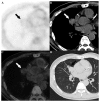18F-FDG PET/CT characteristics of pulmonary sclerosing hemangioma vs. pulmonary hamartoma
- PMID: 29930720
- PMCID: PMC6006501
- DOI: 10.3892/ol.2018.8660
18F-FDG PET/CT characteristics of pulmonary sclerosing hemangioma vs. pulmonary hamartoma
Abstract
The radiological features of pulmonary sclerosing hemangioma (PSH) and pulmonary hamartoma are poorly specified. Thus, the present study aimed to compare and analyze the characteristics of fluorodeoxyglucose positron emission tomography/computed tomography (18F-FDG PET/CT) in PSH versus pulmonary hamartoma. 18F-FDG PET/CT characteristic findings of 12 patients with PSH and 14 patients with pulmonary hamartoma were retrospectively reviewed. A total of 12 lesions were detected from the 12 patients with PSH, of which 3 masses exhibited calcification. The mean diameter and standardized maximum uptake value (SUVmax) were 1.9±0.7 cm and 2.6±1.0, respectively, and there was no significant correlation between the lesion size and SUVmax (P>0.05). For the 14 patients with pulmonary hamartoma, 14 lesions were found, of which 4 exhibited calcification. The mean diameter and SUVmax were 1.7±0.8 cm and 1.5±0.6, respectively, and there was a significant correlation between the size and SUVmax (r=0.625, r2=0.391, P<0.05). Although there was no significant difference between the size of PSH and pulmonary hamartoma (P>0.05), the SUVmax of PSH was significantly higher than that of pulmonary hamartoma (P<0.05). Moreover, the SUVmax of 1.95 was applied as a cutoff for the diagnosis of PSH, and the resulting sensitivity and specificity for PET/CT to differentiate PSH from pulmonary hamartoma were 83.3 and 78.6%, respectively. Although the morphological features were not specific, PSH showed significantly higher FDG accumulation than pulmonary hamartoma on PET/CT imaging, which may aid the differential diagnosis. Further studies with larger populations are warranted to confirm these study results.
Keywords: fluorodeoxyglucose; positron emission tomography/computed tomography; pulmonary hamartoma; pulmonary sclerosing hemangioma.
Figures






References
LinkOut - more resources
Full Text Sources
Other Literature Sources
